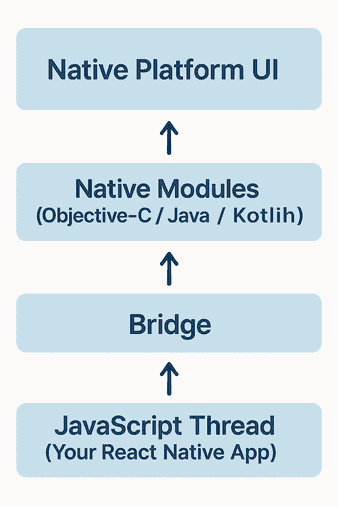Chapter 1: Introduction to React Native
You’re a web developer. You know React.js. You're used to building fast, component-driven web apps that run in browsers.
Now, you want to build real native mobile apps for iOS and Android—without learning Swift, Objective-C, Java, or Kotlin from scratch.
React Native makes that possible.
In this chapter, we’ll cover:
- What React Native is and how it works
- How it compares to React.js
- The React Native architecture (JS thread, native modules, bridge)
- Setting up your development environment
- Running your first app on an emulator or real device
By the end, you’ll have a running mobile app and know how the React Native runtime connects JavaScript and native platform APIs.
1.1 What is React Native?
React Native is a framework for building native mobile apps using JavaScript and React.
But here's the key: React Native does not render to HTML and CSS like React.js does.
Instead, React Native maps your React components to native platform UI elements like UIView (iOS) and View (Android).
This gives your app real native performance and look-and-feel, not just a web view wrapper.
React Native Rendering Model vs React.js Rendering Model
| Feature | React.js (Web) | React Native |
|---|---|---|
| UI Targets | HTML, CSS | Native platform components |
| Rendering Engine | Browser DOM | Native rendering engine |
| Styling | CSS | JavaScript StyleSheets (Flexbox) |
| Navigation | React Router | React Navigation / Native APIs |
1.2 How React Native Works (Architecture Overview)
React Native runs your JavaScript code using a JavaScript engine (Hermes, JSC, or V8), separate from the main UI thread.
Core Architecture Layers
Key points:
- Your JS code runs in a separate thread from the UI thread.
- Communication between JS and Native happens over a Bridge using serialized messages (though new architectures like JSI and Fabric reduce bridge overhead).
- Heavy tasks on JS thread can block UI responsiveness (we'll cover how to avoid that later).
1.3 Setting Up Your Development Environment
You have two main setup options:
Option 1: Expo (Easiest for Beginners)
Expo is a managed development environment for React Native that handles build configs and native code for you.
Best for:
- Beginners
- Rapid prototyping
- Apps that don’t need heavy native module customization
Setup:
npm install -g expo-cli
expo init MyFirstApp
cd MyFirstApp
npx expo startYou can preview your app using the Expo Go app on your real Android/iOS device.
Option 2: React Native CLI (For Full Native Control)
This is the bare metal way. You’ll need Android Studio and/or Xcode installed.
Best for:
- Apps needing custom native modules
- Advanced deployment configs
Setup:
npx @react-native-community/cli init MyFirstApp
cd MyFirstApp
npx react-native run-android
# or
npx react-native run-iosPro Tip: Start with Expo for learning, switch to React Native CLI when you need full control.
1.4 Running Your First React Native App
Example: Minimal “Hello World” App
Here’s the simplest React Native app:
import React from 'react';
import { Text, View, StyleSheet } from 'react-native';
export default function App() {
return (
<View style={styles.container}>
<Text>Hello World from React Native!</Text>
</View>
);
}
const styles = StyleSheet.create({
container: {
flex: 1,
justifyContent: 'center',
alignItems: 'center',
backgroundColor: '#f0f0f0',
},
});Explanation:
- View: The React Native equivalent of a
div - Text: React Native component for text display
- StyleSheet: Instead of CSS, we use a JavaScript-based style object
Run this on your emulator or real device and you’ll see: “Hello World from React Native!”
1.5 Common Beginner Errors (and How to Fix Them)
| Error | Fix |
|---|---|
| Metro Bundler not starting | Run npx react-native start |
| Emulator not showing the app | Rebuild with run-android or run-ios |
| Syntax error from wrong component import | Double-check import paths |
1.6 Your First Assignment
Before moving to the next chapter:
✅ Task: Create a new screen that says:
Try changing the background color and font size using the StyleSheet.
Chapter Summary
In this chapter, you learned:
- How React Native works
- The difference between React.js and React Native
- How to set up your environment using Expo or React Native CLI
- How to run your first app on a device or emulator
What is Next?
In Chapter 2, we’ll dive into project structure, file organization, and how to create scalable folder layouts for real-world React Native apps.
We’ll also start building our sample project: "Task Tracker Mobile"

